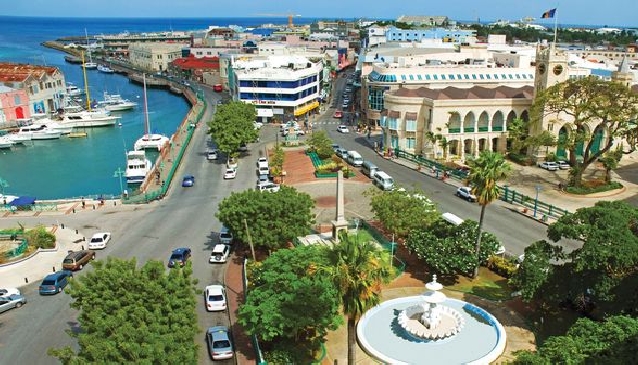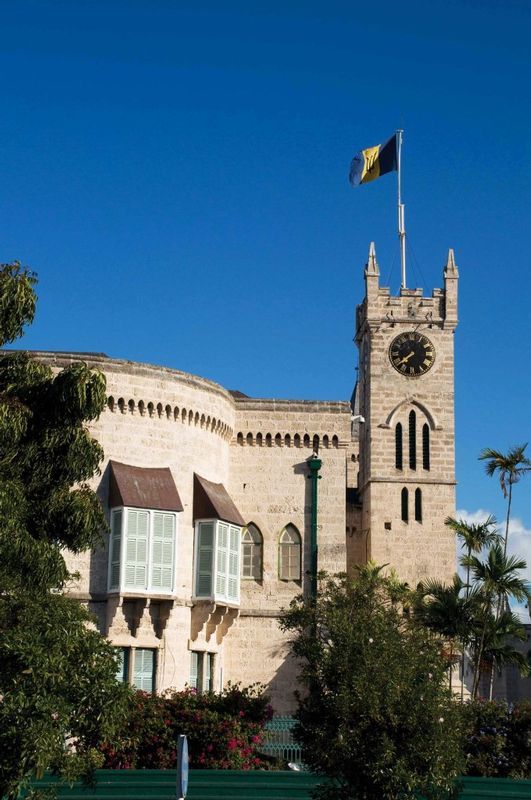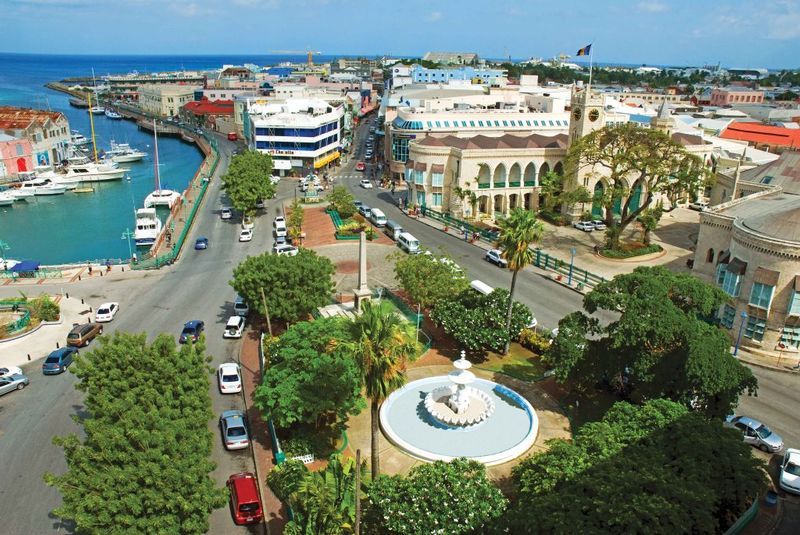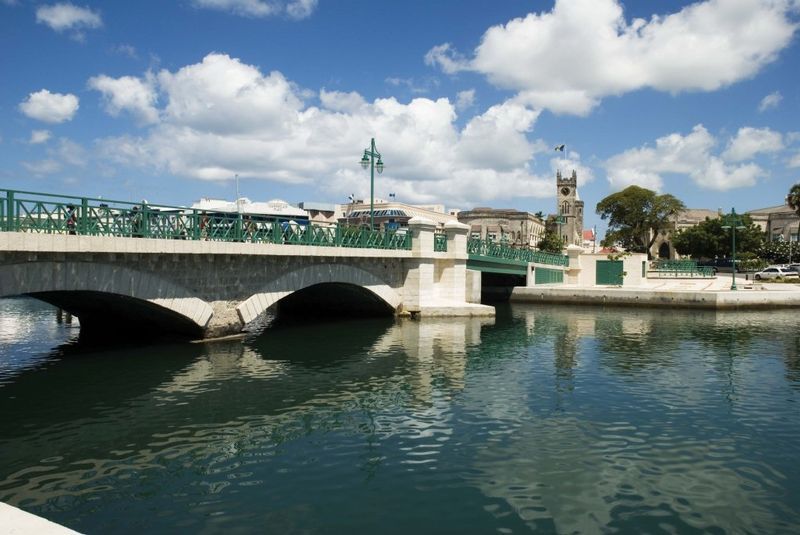UNESCO Recognizes Historic Bridgetown and its Garrison

Distinguished by a degree of preservation that remains relatively unheard of in the rest of the world, Historic Bridgetown and its Garrison offer a rare and fascinating insight into British colonial history. The town, with its dense network of streets built up over the centuries, contains many outstanding examples of British Colonial architecture. The neighbouring Garrison, the site of the former British Military Headquarters in the Caribbean, still retains many buildings with a distinctly military appearance and history. Walking through Bridgetown and exploring the Garrison really is like taking a trip back in time.
But what influenced UNESCO in its decision to nominate this site and what significance does this hold for Barbados and visitors to the island? Let My Destination Barbados fill you in on one of the world’s best-kept heritage secrets.

Barbados has the third oldest Parliament in the world
How did Barbados get recognised?
In 1994 a global strategy adopted by the World Heritage Committee decided that the Caribbean was under-represented in its natural cultural heritage. Fortifications, in particular, were identified as one of the four categories of cultural importance specific to the Caribbean. In 2002 Barbados became a signatory to the UNESCO Convention for the Protection of World Cultural and Natural Heritage Convention, thus becoming eligible forconsideration for nomination. Barbados then submitted an application dossier that detailed four sites on the island to be considered for World Heritage. These included the Scotland District and the Newton slave burial ground, but it was Historic Bridgetown and its Garrison that was ultimately considered most worthy. According to UNESCO’s nomination criteria, this means that the loss of this site would negatively impact on collective world knowledge. Thus, since the summer of 2011, Historic Bridgetown and its Garrison has now joined the ranks of iconic global landmarks such as the Great Pyramids, the Statue of Liberty and the Great Wall of China as a World Heritage site.

Historic Bridgetown and its Garrison is now a UNESCO World Heritage Site
What kind of factors earned this distinction for Barbados?
Bridgetown
UNESCO identified Bridgetown, the largest city in Barbados, as having an outstanding example of British colonial architecture that illustrates the spread of Great Britain’s Atlantic colonial empire. The layout of the town is in many ways much like London. Bridgetown was built over the 17th, 18th and 19th centuries, with buildings of all designs being built randomly, leading to a meandering and twisting street system that seems to leak out of the core of the city. This is quite unusual when compared to other islands, which adhered to the Dutch and Spanish colonial city structure and tended to follow a grid pattern.
Something of interest can be seen on every street corner as each century brought new developments for the city. In its early days Bridgetown was an important trade route and stopping point for ships. Many foreign traders frequented Bridgetown, with its safe anchorage and natural harbour, and each visiting culture left its own mark on the town. A prime example of this is on the corner of St. James Street, where a 17th century townhouse is topped with a traditional Dutch curvilinear gable, marking the city’s links with Dutch traders.
Another unique feature of the city is the Nidhe Israel Synagogue, built by the 17th century Jewish community on the island. Now also a museum, a Mikvah was recently found next to the synagogue in an area that once served as a car park. The Mikvah was used to purify women before marriage or after giving birth, and also men in certain circumstances. It is thought to be one of the oldest examples of a Mikvah in the Americas and is fed by a natural spring.
The Garrison
The Garrison is situated about a mile south of Bridgetown and was said to have had devastating defence capabilities. Strategically located on the south-west of the island, adjacent to the beach at Carlisle Bay and bounded to the east by a garrison wall, this 150-acre complex contains more than 80 individual heritage sites. These architectural gems include forts, officers’ quarters, guard-houses, armoury, hospital, prison, cookhouses, latrines, an underground tunnel system and the world’s finest collection of 17th Century English Cannon. Since 1933, the Garrison has been home to The Barbados Museum & Historical Society that records and preserves the island’s history. There are several sections to tour around the Garrison but perhaps the best place to start is at the famous red building with a striking clock tower, the Main Guard Headquarters, which used to be the official entrance to the Garrison area. While here you should look out for the Changing of the Sentries ceremony, which usually occurs at noon on designated days.
Charles Fort
Charles Fort is the oldest and largest of the forts to be found in Barbados and was built in 1650. In 1665 it destroyed an entire Dutch Fleet attempting to attack the island. The fort’s impressive stone walls, now situated within the grounds of the Hilton Barbados, with cannons still mounted on its battlements, look the same as it would have done 400 years ago - a formidable obstacle for any attacker or pirate.
The Garrison Savannah
Established around 1808 as the centrepiece and parade ground for the surrounding military barracks, the Garrison is today better known for its horseracing track. The Barbados Turf Club built the track in 1905, making it the oldest in the western hemisphere, and it is said to be one of the most challenging race-tracks in the world. A host of other sporting events take place here including cricket, football, running and cycling. It is also home to the Barbados Rugby Club.
The Garrison Tunnels
Stretching over two miles underneath the Garrison, these mysterious tunnels seemingly used to provide drainage for the marshy Savannah, but may have also facilitated the secret movement of persons, dead or alive, from the Garrison area to the beach. The tunnels are very soon to be opened to the public for tours.
St. Ann’s Fort
Built some 220 years ago, this fort has been turned into the National Armoury Museum, housing some of the finest English 16th and 17th century cannons to be found anywhere in the world, including a number of unique guns.
George Washington House
This is where the 19-year-old George Washington stayed in his only visit to any country outside the United States. It aims to provide an insight into this fascinating and pivotal time in George Washington’s life. It also allows access to the hidden Maycock Gully, the last remaining natural gully system in urban Barbados.

The Careenage in Bridgetown with the Swing Bridge in the foreground and the Parliament in the background
What does this UNESCO recognition mean for Barbados and visitors to the island?
Blessed with an ideal climate, superb white sand beaches, clear azure-blue sea and lush natural beauty, Barbados has long been renowned as one of the world’s most popular tropical vacation destinations. Those people who have already visited the island will also tell you that Barbados has a lot more to offer than just the traditional ‘sun, sea and sand’. They would probably mention the welcoming people, fantastic food, enjoyable lifestyle and possibly even that ‘x-factor’, the intangible something or other that makes visitors fall in love with this special island. Now we must also add world-class heritage to that list of accolades.
One of the major impacts of the awarding of UNESCO World Heritage Site Status to Historic Bridgetown and its Garrison is that this extremely important aspect of the island’s national identity has now been thrust into the limelight for both Barbadians and visitors alike. Barbadians who have for their whole life walked past buildings of historic importance will now regard them in a different perspective and see a greater value in them. In the longer term, this new self-identity will evolve into a greater sense of pride for Barbadians. Ideally, it will also generate a greater desire to preserve the island’s rich heritage as well as a will to add to it for the benefit of future generations.
On the international level, Barbados has now been clearly marked as a destination that can offer tremendous attraction to people who have a passion for history and heritage tourism. Visitors to Barbados can literally ‘live history’ by going to and experiencing the numerous heritage sites that exist, all neatly packaged into this compact island measuring just 21 x 14 miles.
As well as being blessed with the best ‘sun, sea and sand’, Barbados today can proudly and justifiably also claim to have an unparalleled collection of globally significant heritage attractions. Visitors to this special island can now enjoy the best of both worlds.